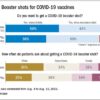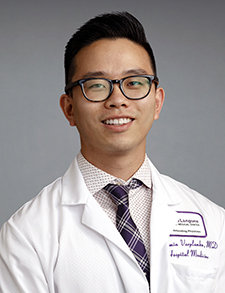
Dr. Verplanke
As he reflected upon his days as a hospitalist and unit medical director within the division of hospital medicine at NYU Langone Health in New York, since the COVID-19 pandemic began, Benjamin Verplanke, MD, FACP, said, “It can be daunting to know that as soon as you discharge someone, two people are waiting for that bed.”
The coronavirus, and now the delta variant, have contributed to overcrowding at hospitals and other challenges such as resource shortages. For the AdventHealth Central Florida Division, a six-county region in and surrounding metro Orlando, Fla., retaining enough nurses has been the biggest challenge. Many existing nurses were travelers, and some employees left to become travelers to hotspots, said Neil Finkler, MD, senior vice president, and chief clinical officer. As the pandemic wore on, the physician workforce also experienced significant constraints at the 4,500-bed system, which has hospitals in urban and rural areas, including specialty hospitals for women and children.
Oregon Health & Science University (OHSU) in Portland, Ore., stopped all elective surgeries and procedures during the first wave of COVID-19, per a state mandate, and consequently had a large backlog to manage when it offered them again. Then, during the delta surge, the hospital had a high volume of local COVID-19 patients as well as a high burden of non-COVID transfer patients due to extremely severe COVID-19 outbreaks in other parts of the state, said Stephanie Halvorson, MD, FACP, associate professor of medicine and division chief of hospital medicine at the 576-bed adult and pediatric hospital.
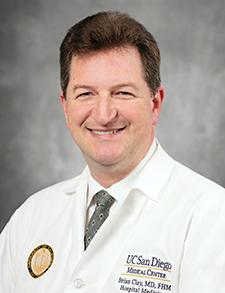
Dr. Clay
Brian Clay, MD, health sciences clinical professor of medicine, chief medical information officer, and associate chief medical officer for inpatient care in the department of medicine at University of California San Diego (UCSD) Health in San Diego, is seeing more outpatient volume at the 808-bed academic facility—which can lead to increased hospital-based surgical procedures and referrals to the emergency department. Like OHSU, UCSD is also seeing a fair amount of deferred care in the region given the previous COVID-19 waves last winter and summer.
The pandemic has also had negative impacts on many community-based systems of support and care. Nejat Zeyneloglu, MD, MBA, FHM, chief medical officer at Central Vermont Medical Center in Berlin, Vt., has seen an increase in mental health needs, uncontrolled chronic medical problems, and delayed care at the 122-bed, non-profit, rural community hospital. Additionally, placements in short-term rehabilitation or long-term-care facilities have been hampered by outbreaks.
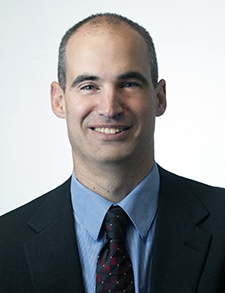
Dr. Hilger
With the latest coronavirus surge in late 2021, Rick Hilger, MD, SFHM, system utilization management medical director and hospitalist in the department of hospital medicine at HealthPartners in Minneapolis, an urban, tertiary-care, health system with more than 1,000 beds, has also seen a lack of staffing and beds at skilled nursing facilities (SNFs). “It has become difficult to discharge patients requiring rehabilitation services due to a lack of staffing in the post-acute care setting,” he said. He attributes this to the Centers for Medicare & Medicaid Services (CMS) waiving the three-day requirement to qualify for SNF coverage, and most commercial health plans waiving pre-authorization requirements under these circumstances. “These changes revealed the inefficiencies created by these artificial hurdles to progressing care; we need to find a better way forward.”
Addressing staffing shortages
As a result of overcrowding, hospitalists at regional sites affiliated with Aspirus Medical Group, a rural health system in Wausau, Wis., often care for patients at higher acuity levels than they’re accustomed to, said Steve Phillipson, MD, FHM, director of hospital medicine. They assist emergency-medicine colleagues when boarded patients in the emergency department are awaiting transfer. The system has about 300 beds in Wausau and around 400 more in the region.
At one point, a national disaster medical assistance team augmented intensive care unit (ICU) staff capability at one of Aspirus’ critical-access hospitals, which enabled it to open additional beds there. “That extra capacity was crucial to our patients and system during the last wave,” Dr. Phillipson said. “We also have data on bed availability at SNFs and hospitals outside our system in case we need to transfer patients there.”
Since the coronavirus began, NYU Langone Health has increased its acute medical floor census, therefore requiring more physicians and nurses at the 760-bed, urban academic center. “We have increased our hiring pool of hospitalists and nurses; we use per-diem nurses as well to help fill in gaps,” Dr. Verplanke said. “We have increased moonlighting to residents, fellows, advanced-care providers, and physicians.”
AdventHealth strives to have nurses work at the top of their licenses and found implementing telenursing to respond to COVID-19-patient care to be quite invaluable.
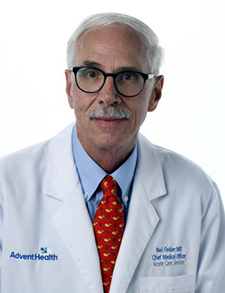
Dr. Finkler
AdventHealth began using new predictive models for planning. “Our leadership asked us to forecast what would happen in the next week regarding peaks, troughs, and future surges,” Dr. Finkler said. By using new data sources, the health system learned that an increase in the outpatient antigen testing positivity rate (APR) at urgent care centers consistently correlated with a subsequent increase, two weeks later, in the number of COVID-19 hospitalizations and ICU admissions.1
Managing resources
In addition to staff, some health systems grappled with having enough supplies. Although supplies were plentiful at AdventHealth’s Central Florida Division locations, new processes were developed to distribute supplies among the organization’s 50 hospital campuses that needed them most. “We used predictive models to quickly develop a system to move around supplies and other assets, such as pharmaceuticals, when one region was in a surge and another wasn’t,” Dr. Finkler said. “This was the first time we ever had to do this.”
Dr. Zeyneloglu has seen the value of reusable or multi-use spaces and supplies. “We think about sustainability and flexibility much more,” he said. “We have regular meetings to review the availability of supplies and assess whether availability triggers turning off a service.”
Working with other partners
Increasing communications within departments, health systems, and external partners has been crucial to hospitals’ success in battling the coronavirus. Hospitals’ relationships with health departments, government officials, and communities grew during the pandemic.
As a health system that serves a small state (Vermont), Central Vermont Medical Center already had solid connections to the community and state health department, which strengthened during the pandemic, Dr. Zeyneloglu said. “Partnerships with health and human services agencies and non-profits were invaluable in terms of mobilizing cloth-mask production and reducing ED visits at the pandemic’s onset,” he said. “Our emergency preparedness team is much better connected to small volunteer efforts that serve towns with populations ranging from 1,300 to 9,000 within our health care system. The vaccination effort also improved our ties to area first responders and community health providers.”
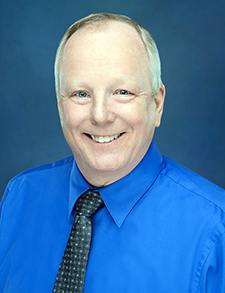
Dr. Phillipson
Aspirus established local incident command centers at each of its 17 hospitals and a system-wide, emergency operating command center to address pandemic issues. Each day, center personnel meet to discuss issues specific to the site and disseminate information relative to the region and the regional response. “This has helped us to stay nimble in the face of a shifting crisis,” Dr. Phillipson said. Other measures included creating a medical operations command cell that helps facilitate inpatient transfers among hospitals in its system to move patients closer to home and optimize bed usage.
Internally, Aspirus provided daily COVID-19 updates to team members and leveraged standard tools such as the intranet and newsletters to facilitate effective communication among staff. The emergency operating command center served as the clearinghouse for information.
Public education has also been critical throughout the pandemic. Early on, Aspirus established three key public information sources:
- Regular media briefings featuring clinical and non-clinical leaders held at its tertiary-care center, live-streamed to media partners in its service area and beyond
- A robust COVID-19 resource center on its public website
- A dedicated COVID-19 call center hotline, where people could ask questions and schedule COVID-19 testing and vaccination
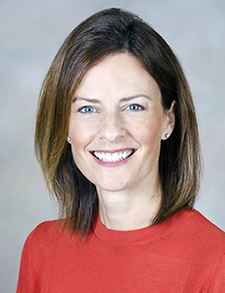
Dr. Halvorson
Dr. Halvorson found it helpful to have close relationships with other hospitalist leaders in Portland. “We communicated regularly to address questions and concerns in real time,” she said. Some topics included the timing of mask mandates, strategies for effective team communications, and how systems were managing PPE. “This shared experience and learning at the leadership level has been extraordinarily helpful.”
Changes in discharge processes
Hospitalists have been on the front lines of decision making regarding discharge processes and other operations. Getting patients discharged faster has been a priority during the pandemic. “Some patients that Aspirus previously might have kept in the hospital were sent home with close outpatient follow-up by their primary care team,” Dr. Phillipson said. “Discharge protocols were developed with home health services for ED patients who would have stayed in the past.” He reports success in managing patients at home at higher levels of acuity than in the past.
Although previously NYU Langone Health wouldn’t discharge patients to their homes if they needed supplemental oxygen, that protocol changed. Now patients who are otherwise feeling better but are still mildly hypoxic are sent home with supplemental oxygen and pulse oximeters.
Because all subacute rehabilitation and SNFs require COVID-19 tests within one to two days of accepting a patient, NYU Langone Health uses rapid polymerase chain reaction (PCR) tests to ensure they can be completed quickly.
Further, NYU Langone Health created a unit for lower acuity patients who weren’t ready to leave. “This allowed us to open space for more acute patients and create a dedicated team to focus on patients with more complicated discharge plans,” Dr. Verplanke said.
To discharge more patients due to overcrowding, AdventHealth began remotely monitoring patients through a new service called DispatchHealth. COVID-19-positive patients who met certain criteria could leave and have their oxygen levels monitored at home. If anything alarming occurred, the patient was asked to return to the hospital. “This has been a remarkable way to save space, particularly during the Delta surge in August when space was at a premium,” Dr. Finkler said.
UCSD Health expanded its use of discharge lounges, which allowed discharged patients to wait for transportation without having to continue to occupy a hospital bed.
Changes in operations
In addition to discharging patients faster, hospitals made other changes to their operations. One of OHSU’s biggest changes was to transfer patients with long lengths of stay but low medical complexity (e.g., patients awaiting guardianship, or those who were stabilized after a long duration of IV antibiotics) to one of its two community hospital partners to free up beds at the academic site. This successful effort opened up more than 350 hospital bed days at its academic site in the first quarter of 2021.
That said, this strategy has contributed to a chronically higher census at one of its community sites, so OHSU is looking to increase staffing to support the team there. Going forward, Dr. Halvorson anticipates maintaining this model because it also consolidates case management and nursing needs to allow for stronger discharge planning for these complex patients.
OHSU tried another strategy,2 which wasn’t successful, early in the initial coronavirus surge, in which it transferred a similar patient population (such as patients awaiting discharge) down to its outpatient care unit/day surgery center. These patients required complex discharge care coordination involving the pharmacy, laboratory, nutrition services, and environmental services.
“Ultimately, this initiative was not worth the small number of patients who we were able to transfer, so we abandoned the effort,” Dr. Halvorson said. “I think we’ve been more successful in transferring these patients to one of our partner, community hospitals because they already had all of the necessary services in place and dedicated case management.”
NYU Langone Health increased its ICU staff and acute medicine staff to make it possible to almost completely fill its hospital with COVID-19 patients. This included all medical and surgical floors, as well as its pediatric floor. The health system had recently built a state-of-the-art facility in which every floor could be converted to an ICU, which was a great help, Dr. Verplanke said. Leadership recruited outpatient physicians and advanced-practice providers from the community to work on COVID-19 floors. It also recruited physicians and nurses from other states.
Throughout the pandemic, AdventHealth’s workforce and shift resources became more nimble. Because the Accreditation Council for Graduate Medical Education suspended rules for medical residents during the pandemic by implementing crisis standards of care, AdventHealth could use graduate medical education students and medical residents to cover for hospitalists who moved to the ICU to help intensivists. By having crisis documentation standards approved at the state level, nurses could limit their documentation to just the essential, safety components. This alleviated how much time nurses spent documenting in electronic medical records (EMRs) and freed them up to be at the bedside in the middle of an unprecedented staffing crisis.
Hospitalists’ roles
Hospitalists have played multiple integral roles in making significant changes. “Hospitalists have been at the table and involved in every decision we’ve made,” Dr. Finkler said. “They’ve been at command centers—both at the corporate and national levels—and within the localized Central Florida division level.”
At OHSU, hospitalist leadership worked to implement acute care and surge plans throughout its three institutions and participated in other key efforts such as committees focused on securing PPE supplies, patient cohorting, and developing COVID-19 testing pathways and protocols. “We drew from strong relationships with other inpatient services (e.g., cardiology, oncology) to get support when needed (e.g., surge planning),” Dr. Halvorson said.
“Hospitalists are truly the ‘hub’ in a hub-and-spoke model of hospital systems. We interact with everyone. We understand the importance of every person and role and have a good understanding of what they do. This allows us to partner and creatively solve problems with colleagues across disciplines and job types.”
Hospitalists at UCSD Health serve in numerous leadership positions, including chairing multiple hospital committees, leading quality and safety efforts, and running clinical-informatics teams. “Hospital medicine worked closely with infection preventionists to implement standard COVID-19 management protocols, and with the EMR team to build the necessary COVID testing algorithms, patient instruction content, and clinical decision support tools,” Dr. Clay said.
Lessons learned
Many lessons have already been learned from working during the pandemic. “Adapt, adapt, adapt, and learn to be resilient,” Dr. Zeyneloglu said. “Our staff is our most precious resource and we must do what we can to prevent stress and burnout.”
Perhaps the most important lesson AdventHealth learned was to accept failure as part of innovation. “Overcoming the fear of failure and accepting that failures are important steps along the road to transformation is a necessary change in the mindset of future clinical leaders,” Dr. Finkler said.1
Dr. Halvorson has learned that “relationships are everything. The pre-existing relationships we had throughout the hospital and with the executive leadership team allowed us to quickly collaborate and develop surge plans,” she said.
And communication is key. OHSU developed a single system of communication including a daily huddle and email during the surge’s busiest part. “This was a quick way to share information and address concerns in real time,” Dr. Halvorson said.
Leaders can learn a lot from one another, even though they work at competing health systems, Dr. Halvorson continued. “I have borrowed many good ideas from my peers,” she said. “I joined the multi-site leaders’ special interest group through SHM, and have similarly found this to be a wealth of practical information.”
Finally, hospitalists are essential. “If there was ever doubt about that before, we have proven our value to our systems and communities,” Dr. Halvorson said. “We showed up for work consistently, even in the early days when little was known about COVID-19 and anxiety was high. I will forever have a deep appreciation for my colleagues and hospitalists everywhere.”
References
Finkler N, Herrera V. Five areas to redefine the clinical leader of the future. NEJM Catalyst. November 18, 2021. Available at: https://catalyst.nejm.org/doi/full/10.1056/CAT.21.0339. Accessed December 14, 2021.
O’Glasser AY, Stroup S, Merkel MJ, et al. Rallying all resources: a multidisciplinary innovation to plan for the projected COVID-19 inpatient surge. J Nurs Care Qual. April/June 2021;36(2):112-116.
Karen Appold is an award-winning journalist based in Lehigh Valley, Pa. She has more than 25 years of editorial experience.
